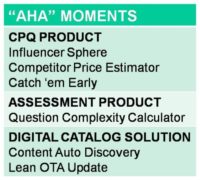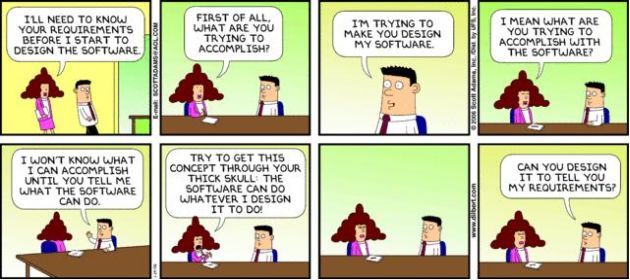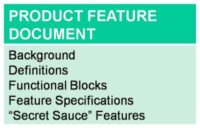The typical tech startup’s backstory goes as follows:
Founders observe a problem in the real world, find a way to use technology to solve the problem, and build a product around the technology.
According to common wisdom, product management is the foundation of any startup. Sales, marketing, HR, finance and other functions can come in later.
Therefore, whenever we pitch our “outsourced product management” service, leaders of many technology companies raise their eyebrows.
Some go beyond: When we raised this topic with one of our customers, Atul Narkhede, Co-Founder and Advisor at kPoint Technologies, he almost rasped, “Who the heck outsources product management?”
Valid question.
We answered it (hopefully) to the satisfaction of Atul.
Since the same thought may be running through others’ minds, we thought we’ll provide a gist of our answer in this this blog post.
It makes sense for startup founders and product managers of established companies to seek external help for product management under the following scenarios.
#1. Create Global Appeal
Different countries have different nomenclature, regulations, business culture, cost-versus-revenue sensitivity, tolerance to friction, availability of external sources of data, and so on. Therefore, it’s but natural for a software developed for one country to need changes to suit another.
Creating a core product is a fulltime job in itself.
Product managers lacking internal bandwidth to localize their products for different markets outsource the task.
#2. Elevate Product to New Heights
In the course of packaging a software, we often discover new ways to position the product that make it considerably more marketable than its current positioning.
The repositioning often calls for new functionality. Startup founders wishing to leverage the new positioning entrust us with the task of spec’cing the required modules and underlying features.
We did this recently for a company that began life as a developer of a loyalty rewards management software. We worked with the company to raise its product to the next level and provided specs for additional modules for enrollment, engagement and analytics. After developing the new functionality, the company has been able to position itself as a leading provider of Customer Engagement Management software.
#3. Outflank Leader
Many founders assume that the first version of their product should be an MVP and develop only a subset of the product category leader’s feature set.
There are two limitations with this approach.
One, going by an MVP’s purpose to “ensure that the market wants the product before a large time and monetary investment is made” (Source: Wikipedia), this approach is suitable only for pioneering vendors that launch the first product in a new category.
Two, a non-pioneering new product can’t win by supporting a subset of the incumbent leader’s functionality. After all, why should a prospective customer bother with a newbie’s truncated v1 when they can very well buy a richer product from the incumbent leader?
This is not to say that only early movers succeed. As the legend goes, Word was not the first word processor, Excel was not the first spreadsheet and Google was not the first search engine. But it’s a fact that the very first version of all these products that went on to become blockbusters were superior to the then incumbent leaders WordStar, Lotus 1-2-3 and Lycos.
 We do agree that it’s well nigh impossible for a fledgling company with limited resources to match the functionality of the leader’s product developed over years or even decades.
We do agree that it’s well nigh impossible for a fledgling company with limited resources to match the functionality of the leader’s product developed over years or even decades.
This is a conundrum and it catches new product developers between a rock and a hard place.
They can get out of there by playing the incumbent leader’s strengths against itself. We help companies to outflank incumbents with differentiated functionality and aha moments, as we did recently by tacking on the “Influencer Sphere” functionality of social selling on top of a new Configure-Price-Quote product.
#4. Enhance CX
By now, most products have appreciated the need to go beyond core functionality and pay attention to UI.
However, as competition intensifies, good UI is no longer sufficient. UX and CX have become critical to ensure customer success.
UI: Nice-looking form;
UX: Questioning need for form;
CX: Shaping UI & UX based on customer journey inside & outside S/W.— GTM360 (@GTM360) June 13, 2016
SaaS and Internet services product managers that are challenged in these areas can turn to us for help. See “Retail Bank Sees Strong Uplift In Online Customer Acquisition” and “Leading Insurer Boosts Sales” for more details of how we helped a bank and an insurer increase conversion and enhance usage of their cloud solutions.
#5. Migrate From Onprem to Cloud
Many companies port their onpremise software to the cloud, treating the migration as a mere change in the deployment method. Accordingly, they don’t envisage any change in functionality.
While this may be a technically correct approach, it has the unintended consequence of curtailing the adoption of the cloud version. Stunted adoption doesn’t matter so much for onprem software vendors because they collect the entire license fee upfront regardless of adoption rates. But it can kill a cloud vendor who relies on user count and enhanced usage to drive monthly subscription renewals and to grow ongoing revenues.
We can remedy this situation by specc’ing the functionality for the cloud version. See “LCMS Vendor Accelerates SAAS Subscription Revenues” for a case study.
#6. Productize Repetitive Services
Through years of providing services to dozens of customers, many IT Services companies have gathered massive expertise and built proprietary frameworks in many areas. Their leadership often wishes to translate their internal capability and IP into one or more products, with the twin goals of moving up the IT value chain and enhancing their company’s valuation.
However, lacking an inhouse product manager and unsure of the business case of hiring one on a full time basis to carry out this exercise, they’re stuck.
We pull such companies out of the rut by providing end-to-end product management services comprising portfolio analysis, clustering hot product categories, narrowing down to the correct category, outlining functional blocks of the solution and providing high-level specs for v 1 of the product. (Portfolio analysis is also applicable for product companies that have ended up developing too many products over time and want to prune their portfolio before running market ourteach campaigns.)
As is clear from the above scenarios, the scope of outsourced product management can range from minor tweaks and enhancements through to fully fledged products and new versions.
The deliverable of our outsourced product management service is a Product Feature Document, the TOC of which is shown in the exhibit on the right.
(Just to be clear, the actual coding and testing work related to the product is done by our customers i.e. the original product or services company we work with.)

